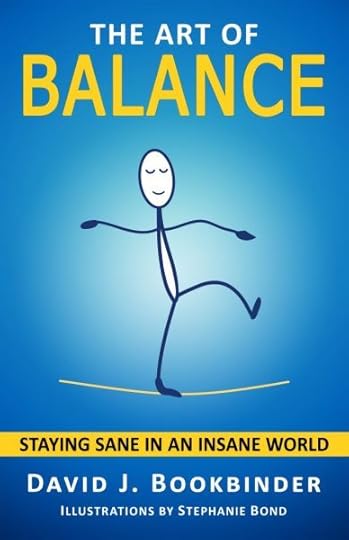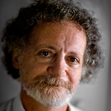David J. Bookbinder's Blog, page 4
February 6, 2018
Launched!
Launched!
Launched!
A legion of UnBalancers has been unleashed upon the Earth –
Along with the means to send them scurrying!
Or, to put it another way, my new self-help book – The Art of Balance: Staying Sane in an Insane World – is now out, just in time to battle stress, anxiety, winter doldrums, and whatever the evening news delivers next.
I’ve boiled down everything I’ve discovered about staying sane in this insane world in my 15 years as a therapist and life coach into one power-packed volume, and so far the response among early reviewers has been very positive:
“I cannot say enough about The Art of Balance. It’s an amazing manual for re-balancing one’s life!”
“If you want to avoid a long-winded and theory-based self-help book, then this is the book for you. David provides practical exercises that are easy to follow and they really do work. Even if you have a hectic lifestyle David gives you quick exercises to perform wherever and whenever you can fit them in.”
“In an age of anxiety this book provides a reliable system for immunizing yourself against the effects of stress”
“I am loving the book – everything about it! The organization, the quotes at the beginning of each chapter, the stick figures and the characters’ names. I already have people in mind to recommend it to.”
“This is a must-read for anyone struggling with emotional challenges from either internal turmoil or events that seem to be out of our control.”
The ebook version of The Art of Balance is on sale for one week only for $0.99!
Here are some links to share with your friends, family, and anyone else who might be interested in bringing balance and equanimity to their lives:
Buy (and Review!) The Art of Balance on Amazon.com
Visit The Art of Balance website
Download The Art of Balance cheat sheet
Review The Art of Balance on Goodreads.com
Share The Art of Balance on Facebook
Share The Art of Balance on Twitter
Thanks for looking and TIA for sharing!
P.S. More enthusiastic responses:
“I found The Art of Balance empowering and self-motivating. It truly was difficult to stop reading once I began.”
“This book really gave me insight and direction.”
“My overall impression is.. bravo! It’s a well thought out self-help book that continued to deepen as I worked my way through it.”
“The Art of Balance is more than the typical self-help book. It’s a companion – a lifelong resource.”
Books
The Art of Balance: Staying Sane in an Insane World
Paths to Wholeness: Fifty-Two Flower Mandalas
52 (more) Flower Mandalas: An Adult Coloring Book for Inspiration and Stress Relief
52 Flower Mandalas: An Adult Coloring Book for Inspiration and Stress Relief
Paths to Wholeness: Selections (free eBook)
January 31, 2018
Coming AttractionsThe Art of Balance

I’m doing the final tweaks on the book, ebook, and website for The Art of Balance. Here’s what some early reviewers are already saying about it:
“I found it empowering and self-motivating. It truly was difficult to stop reading once I began.”
“A self-help book that actually helps!”
“If you want to avoid a long-winded and theory-based self-help book, then this is the book for you. David provides practical exercises that are easy to follow and they really do work.”
“This book is very motivating and extremely validating!”
“Comes at the subject in a simple, easily understood approach. I found myself not wanting to put it down.”
“This book is a must have for artists and creative people.”
“Whether you’re in a recovery program or just feel lost, the principles, exercises, and examples in this book can help regain a feeling of purpose and direction. It did for me.”
“Definitely a must read.”
“I would recommend Bookbinder’s newest effort to anyone struggling with issues in recovery that relate to maintaining lifestyle balance.”
“The Art of Balance was a fascinating read full of helpful information on finding balance. The section on mini self-care was particularly helpful especially when dealing with a very hectic schedule.”
And here’s a peek at the rear cover:

I’m excited about this book!
Stay tuned for more, soon –
– David
January 24, 2018
How to Stay Sane in an Insane World
Don’t let your heart be colonized by fear.
– Jack Kornfield
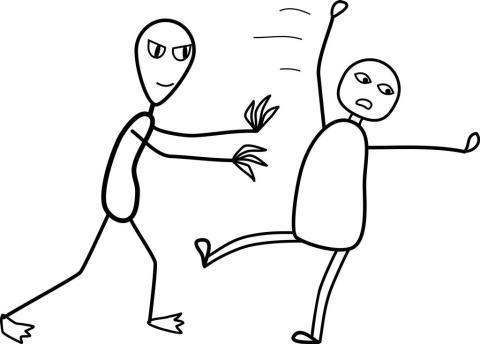
What I Learned About Practicing What I Preach
The Battle for Balance is a life and death struggle. Stay balanced, and we enjoy life to the fullest. Lose balance, and life gets hard.
I’ve learned this lesson many times, over many years, and I’m sure most of you have, too. But a couple of years ago, I discovered that even a therapist with a toolbox full of self-help tools can get unbalanced if he doesn’t practice what he preaches.
A big part of my job is to help people deal with difficulties and uncertainties. Because I’m an empath, while I’m working with them, I’m also feeling what they feel. Usually, I can process those feelings in the moment, so that by the time the next client walks through my door, I’m ready to freshly take in who they are and what they may need.
My work feels like a calling, and that’s a good thing. But there have been two extended periods when too much of a good thing was… too much, and it was in these periods that I truly learned the importance of balance. The first one got me. The second one got me to write a book about balance.
That first time started just as the harsh Boston-area winter of 2014/2015 was ending. Relentless weather not seen in decades seemed to crush the spirits of a lot of people, and beginning in March and continuing for many weeks thereafter, former clients came back to therapy, about one per week. They came not for a tune-up, as I had expected, but for extended stays, and they not only overwhelmed my already pretty full schedule, they also overwhelmed me.
Not their fault at all, of course. I was a victim of my own hubris. Therapists, like anyone, need self-care, but I thought – if I thought at all, really – that I was the exception. Instead, I was the proverbial frog in a pot of gradually heating water.
When my schedule got crowded, I created extended office hours out of what had been my down time. Then, as the clients kept coming, I dropped non-work time almost entirely, eliminating recreational activities, meeting with friends, and finally basic functions such as meal preparation, house cleaning, and car maintenance. When even that wasn’t enough, I cut back on sleep.
You can see where this is going, but I didn’t. My work schedule was grinding me to the bone. By the time the buds were on the trees I drove past on the way to my office, I was too tired and too wired on caffeine to notice. My wake-up call was a blind spot in my right eye, the result of unmonitored high blood pressure. After that, I took steps to regain my balance, but it was several months before I recovered my equanimity.
The next time I experienced a steady return of clients was the fall of 2016 and all through 2017. The unsettling state of this country since that Presidential election brought many people back into therapy, regardless of their political persuasion. But I had learned from my 2014/2015 experience. I took my own advice, and this time I avoided burnout. I also kept track of what was helping me stay sane, and what was helping my clients.
The result: my new book The Art of Balance: Staying Sane in an Insane World.
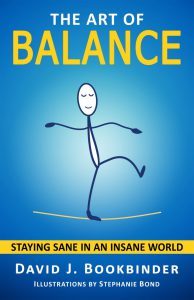
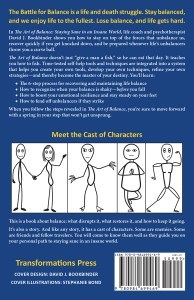 The book is different from other self-help books I’ve seen and, if I can blow my own horn for a moment, it’s better.
The book is different from other self-help books I’ve seen and, if I can blow my own horn for a moment, it’s better.
Unlike most articles on the Internet and a lot of self-help books, The Art of Balance provides much more than a laundry list of the “Top 10 (or 25, or 100) Tools and Techniques.” It’s not a greatest hits. It’s a system.
It’s a system that will help you recognize the forces that knock us out of balance, outline a strategy for overcoming them, and adopt a methodology for achieving lasting balance. The self-help tools and techniques are in there, sure, but they are integrated into a framework that also teaches you how to create your own tools, develop your own techniques, and refine your own strategies—and thereby become the master of your destiny.
The Art of Balance doesn’t “give a man a fish,” so he can eat that day. It teaches you how to fish.
You’ll learn:
The 6-step process for recovering and maintaining life balance
How to recognize when your balance is shaky—before you fall
How to boost your emotional resilience and stay steady on your feet
How to fend off unbalancers if they strike
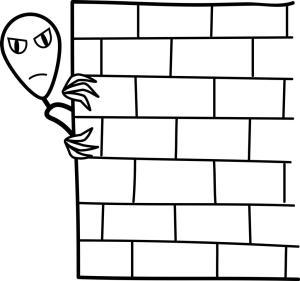
You can see a preview here: The Art of Balance preview
The Art of Balance will be released in early February as both an ebook and a paperback. For a limited time, the ebook will be available for $0.99. Its list price is $4.99. The paperback will be $9.99.
And there’s more!
I plan to help people apply this system to the situations they struggle with in a special group I’m calling The Balance Lab. Some of the types of problems we’ll be working with include:
Acute stresses that can knock us flat, such as an accident, the death of someone close to us, a romantic breakup, a major health crisis, or some other misfortune
Time-limited stresses, such as an overwhelming work load or major event
Chronic stresses that take us down one notch at a time, such as a too-demanding job, a relationship gone awry, or an addictive behavior
I will be drawing on my experiences working with clients as well as my personal experience, but I’m really interested in working with your issues, too.
What are some of the “unbalancers” you experience today, and have faced in the past? Let me know, and I’ll feature some of them here and in The Balance Lab. The Balance Lab is currently open to anybody who buys the book – even at $.0.99.
Please leave your comments on the blog, or you can email them to me.
More to come, including links to the book’s launch page and Amazon.com page, really soon.
– David
January 17, 2018
Guest Post: “Waiting to Die”
NOTE: This is a guest post by Kenneth Ring, PhD. Dr. Ring is an internationally recognized authority on near-death experiences. His writings on this phenomenon include five books and nearly 100 articles about near-death experiences. He is the co-founder of the International Association for Near-Death Studies (IANDS) and is the founding editor of the Journal of Near-Death Studies. Dr. Ring’s book Heading Toward Omega, the Journal of Near-Death Studies, and IANDS were all very important to me following my own NDE in 1993, and I’m honored to have him as a guest.
Waiting to Die
© 2017, Kenneth Ring
The bright realization that must come before death will be worth all the boredom of living.
– Ned Rorem
What’s it like, waiting to die? Of course, it’s different for everyone. I can only say what it’s like for me. On the whole, it’s rather boring.
Don’t get me wrong. I still have many pleasures in life and – knock on silicon – I’m lucky not to be suffering from any fatal illness, though if I were, that would certainly add some drama in my life. I could then follow the example of the poet Ted Rosenthal, who after contracting leukemia, joyfully called his friends and said, “Guess what’s happened to me!” Well, no thanks. I’ll take my boring life any day and intone a hymn of gratitude every morning I wake up with only the ordinary indignities of an old man – coughing, wheezing and sneezing, and, oh, my aching back!
But still….I’m used to having productive work — writing books, helping other authors with their books, being involved in various professional pursuits, and so forth. But recently I published my last book, which I puckishly entitled, Pieces of My Mind Before I Fall to Pieces, which was a kind of potpourri of stories and interests from my later years, and just after that I wrote what I expect to be my last professional article, the foreword to a colleague’s memoir. Now what? More precisely, what do I do with my time now that I have clearly entered the epilogue to my life? Honestly, I feel as if I have stepped over the threshold into my afterlife before dying.
Of course, I can watch films – I’ve become quite a “film buff” in my later years; I still have interesting books to read. I am blessed with a wonderful girlfriend. Still, since life has become a spectator sport for me, and I can no longer travel, except locally, I find that I am spending more time on my sofa, honing my couch potato skills, watching sports. Yet I must confess that even they have lost a good deal of their zest for me. My home town baseball team, The San Francisco Giants, finished in the cellar last year; in golf, Tiger has gone away; in basketball, Michael Jordan is long gone; and in tennis, which is now the only sport I follow with some avidity, it is chiefly because of the great Roger Federer. Nevertheless, I can only wonder how long he can at 36 continue to produce one miracle after another? Surely, he, too, will begin his inevitable decline soon, and with his descent from the heights of glory, my interest in tennis will also flag. So what will be left then? I will tell you.
The body. Mine. It has already become my principal preoccupation and bête-noire. These days, I can’t help recalling that St. Francis referred to the body as “brother ass.” It seems I now spend most of my time in doctors’, chiropractors’ or dentists’ clinics, as they strive to preserve my decaying body parts by inflicting various forms of torture on me that would even impress Torquemada, or doing physical therapy in what is most likely a vain attempt to delay the encroaching onset of wholesale physical deterioration. Really, is this any way to run a navy? There are many days when I think the only surgery that will preserve me would be a complete bodyectomy.
Well, okay, I realize this is only par for the course of the everyday life of an octogenarian. Wasn’t it Bette Davis who famously said “old age is no place for sissies?” It isn’t for wimps like me either, it seems. (I can often be heard crooning, “turn back the hands of time….”) Still, I wouldn’t go so far as the saturnine Philip Roth who said that old age is “a massacre.” I guess at his point I find myself somewhere between Davis and Roth, but the waiting game still seems to be a losing proposition and I might very well come to think of my current boredom as the halcyon days of my decline.
Nevertheless, consider a typical day in the life of this old wheezing geezer.
It begins with the back. Every day does. In the morning, you get up, but your back doesn’t. It hurts. Even though you take a hot shower before bed, by the time you wake up your back has decided to take the day off. When you try to use it, as for example, when you bend over to pick up the comb you’ve dropped into the toilet, it begins to complain.
And finally, it gets so bad, you have to lie down on your once neatly made bed, remove half your clothing, and apply some ice to it while listening to mindless music and cursing the day when some enterprising hominid decided it would be a good idea to change from the arboreal life to a bipedal one. Big mistake. The next one was the invention of agriculture, but never mind. We were talking about the back and its vicissitudes.
Nevertheless, a little later, you decide to take your body out of a spin. “Don’t look back,” the great Satchel Paige advised, “something might be gaining on you.” In my case, it’s the man with the scythe whom I hope to outstrip for a few more years.
Of course, the back, which had only been moaning quietly before now begins to object vociferously, asking sourly, “what the hell are you thinking?” Nevertheless, you press on, thinking your will will prevail, and your back can go to hell.
But the next dispiriting thing you notice are all these chubby old ladies whizzing by you as if they are already late for their hair appointments. How humiliating – to be passed by these old biddies! You think about the days in junior high when you were a track star, setting school records in the dashes and anchoring the relay races, which you used to run in your bare feet. Then you ran like the wind. These days, you are merely winded after trudging a hundred yards.
When you can go no further, you turn around only to become aware of still another distressing sight. Actually, it is your sight – or lack of it. It ain’t working. You could see pretty well after your corneal surgery last year, but now you can’t see worth shit. What is that ahead of you? Is it a woolly mammoth, a Saint Bernard or merely a burly ex-football player? Where are the eyes of yesteryear? Gone missing. Well, they didn’t give me any guarantees as to how long my vision would last before it decided, like my back, to begin to object to its continued use outdoors. The way of all flesh doesn’t stop with the flesh; it continues with the cornea, so now I am cursing the darkness in the middle of a miasmal morning.
I finally arrive home in a disconsolate mood, but now it is time to hop onto my stationary bike, which is the only kind I have ever been able to ride since my balance is worse than that of an elderly inebriate on New Year’s Eve. I used to be able to pedal reasonably fast and for a long time. But lately someone must have snuck in to affix some kind of a brake to the bike since suddenly it seems that I am pumping uphill at an acute angle. Heart rate is up, speed is down, my old distance marks are a treasured memory, which I can only mourn. All I am aware of now is the sound of someone huffing and puffing.
At last the torture is over, but now I really have to piss. That damn enlarged prostate of mine has no patience – it must be satisfied now! I race into the bathroom, unzip my fly before it is too late, and make sure, because I have my girlfriend’s admonitions in my ears as I piss that she will behead me if I continue to treat the floor as an auxiliary pissoir, I am pissing very carefully into the toilet bowl. Of course, these days, my urinary stream is a sometimes thing. It starts, it stops, it pauses to refresh itself, it pulses, stops, dribbles, starts up again with what seems to be its last mighty effort to produce something worthwhile and finally drips itself into extinction.
I’m relieved, however, because at least I haven’t soiled my pants this time. But wait. What is that? Pulling up my pants, I can feel some urine on my left thigh. How the hell did it get in there? Is there some kind of silent secondary stream that runs down the side of my leg when I am otherwise preoccupied with trying to keep my penile aim from going astray?
Now I have to find a towel to wipe off the offending liquid and just hope my girlfriend won’t say, when I return to the kitchen, “what is that funny smell, darling?”
Well, you get the idea. Life is no longer a bowl of cherries, or if it is, some of them are turning rotten. And naturally I can’t help wondering how long I have to go before I really cross that final threshold over the unknown. For years, I’ve joked that I’ve wanted to live to be 1000 – months – old. Now I’m at 984 and counting. I’m getting close, and it’s no longer just a joke.
And of course I now also have to wonder what will be next? I mean, after I die, assuming I will ever get around to it.
Well, in my case, I have some inklings because I’ve spent half my life researching and writing about near-death experiences and in the course of my work I’ve interviewed hundreds of people who have told me what it was like for them to die – at least for a few moments – before returning to life. And what they have told me has been, I am frank to admit, profoundly reassuring.
I remember one woman who said that in order to grasp the feeling of peace that comes with death you would have to take the thousand best things that ever happened to you, multiply them by a million and maybe, she said (I remember her emphasis on the word, “maybe”), you could come close to that feeling. Another man said that if you were to describe the feelings of peace that accompanied death, you would have to write it in a letters a mile high. All this might sound hyperbolic, but I have heard such sentiments from many near-death experiencers. Here’s just one more specific quote from a man I knew very well for many years, telling me what it was like for him to die:
It was a total immersion in light, brightness, warmth, peace, security….I just immediately went into this beautiful bright light. It’s difficult to describe….Verbally, it cannot be expressed. It’s something which becomes you and you become it. I could say “I was peace, I was love.” I was the brightness. It was part of me….You just know. You’re all-knowing – and everything is a part of you. It’s just so beautiful. It was eternity. It’s like I was always there and I will always be there, and my existence on earth was just a brief instant.
After listening to so many people describe what it was like for them to die, it is easy for me to imagine what it might be like for me – for anyone – to take that final journey. And many great writers have said much the same thing as those I have interviewed have told me about what is in store when we die. Walt Whitman, for example, who wrote “And I will show that nothing can happen more beautiful than death.” And Herman Melville, with even more eloquence, said, “And death, which alike levels all, alike impresses all with a last revelation, which only an author from the death could adequately tell.” It seems that in our own time, these authors from the death are today’s near-death experiencers, and the revelations they have shared with us appear fully to support the claims of these famous 19th century American authors.
So having immersed myself in the study of near-death experiences for so many years, I’m actually looking forward to my passage when my time comes. Still, I’m not looking forward to the dying part. In that regard, I’m with Woody Allen who quipped, “I’m not afraid of death; I just don’t want to be there when it happens.” I just hope that all those stories I’ve heard about how wonderful death itself is aren’t some kind of a spiritual trompe l’oeil, a cosmic joke played by a malevolent god. Or as that marvelously antic diarist and composer, Ned Rorem, whimsically jested, “If, after dying, I discover there is no Life After Death, will I be furious?”
Of course, when I am faced with the imminence of death, I hope I’ll be able to comport myself with some equanimity, but who knows? Think of Seneca who wrote so eloquently about suicide, and then horribly botched his own. Well, naturally, I’m not planning to hasten my death by such extravagant means, though I wouldn’t refuse a kind offer of a little help from my doctor friends to ease me on my way if I’m having trouble giving birth to my death. It can, after all, be a labor-intensive enterprise. I just hope I can find myself on that stairway to heaven I’ve heard so much about and can manage to avoid a trip in the opposite direction.
Meanwhile, when did you say Federer will be playing his next match?
Books by David J. Bookbinder
Paths to Wholeness: Fifty-Two Flower Mandalas
52 (more) Flower Mandalas: An Adult Coloring Book for Inspiration and Stress Relief
52 Flower Mandalas: An Adult Coloring Book for Inspiration and Stress Relief
Paths to Wholeness: Selections (free eBook)
… and coming soon, The Art of Balance: Staying Sane in an Insane World
http://www.phototransformations.com
http://www.transformationspress.org
http://www.davidbookbinder.com
http://www.flowermandalas.org
January 10, 2018
Countdown!
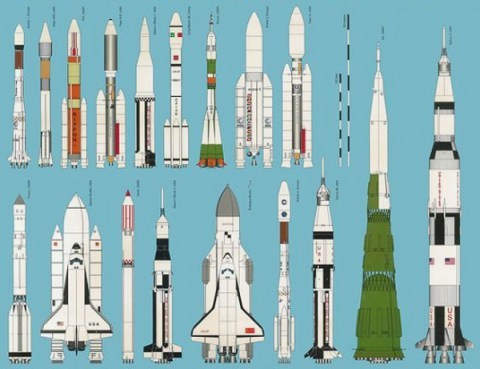
The launch of the Soviet satellite Sputnik when I was 7 years old drew me to science, and especially to space science. In my bedroom, I hung posters of all the Soviet and American rockets and satellites. When I grew up, I wanted to be a rocket scientist and, perhaps, also an astronaut. I was 10 when President Kennedy announced the goal of getting a man to the moon and back by the end of the decade – a goal NASA achieved in 1969, the year I graduated from high school and started at Cornell University’s engineering school, still intent on becoming a NASA engineer.
As a kid scientist, one of the most exciting times for me was watching the countdown to launches at Cape Canaveral. The shots of the giant rockets, the interviews with Mercury 7 and Apollo astronauts and NASA support personnel (including the engineers whose ranks I hoped to join), and the excitement of the countdown itself were among my most thrilling moments.

Although I ultimately became a writer and therapist instead of a rocket scientist, I’ll also soon be doing a launch.
The launch is a “soft launch” of my new book The Art of Balance: Staying Sane in an Insane World. I don’t expect it to match the excitement of sending a man to the moon, but I do expect it to provide help to anyone who is struggling with stress, a loss or misfortune, or just staying balanced in these difficult times.
Click here to see a sampler of The Art of Balance.
It’s a short book with lots of illustrations, but the payload is powerful. Here’s a brief summary:
The Battle of Balance is a life and death struggle: Stay balanced, and we enjoy life to the fullest. Lose balance, and things get hard.
In The Art of Balance: Staying Sane in an Insane World, you’ll learn how to stay on top of the forces that unbalance us, how to recover if you get knocked down, and how to be ready the next time life’s unbalancers throw you a curve ball.
Each chapter provides innovative methods to help you stay balanced and in control of your life now, and also get a leg up on whatever the world throws at you in the future. You’ll learn to:
Recognize when your balance is getting shaky (before you topple)
Bolster your resilience, so you can stay steady on your feet or bounce back quickly
The 6-step process for recovering balance
How to monitor for imbalance and stay on top of unbalancers
When you follow the steps revealed in The Art of Balance, you’re sure to move forward with a spring in your step that won’t get unsprung.
Click here to see a sampler of The Art of Balance.
The countdown has started, and rain or shine, takeoff will occur on 2/1/2018.
Stay tuned, and see you in cyberspace!
David
December 20, 2017
“I Apologize.”

Before I started my training as a therapist, I took a short course in community mediation. Most of my mediation experience was as a volunteer in small claims court. We mediators helped conflicting parties try to reach a mutually satisfying agreement rather than simply letting a judge adjudicate the case.
Small claims court is all about settling financial arguments, and money was always the identified issue in the cases we handled. But in mediation, a strange thing happened: almost always, it turned out that what the aggrieved party most needed was a sincere apology and a way to remedy their grievance. When the apology came (and it often did), the agreement quickly followed. The change in demeanor from start to finish could be dramatic: I remember one case where two women – a homeowner and a landscaping contractor – began in bitter conflict but walked out with their arms around each other, sharing tears.
Something similar happens in couples counseling. Couples often come to therapy as a last resort, with histories of conflict that make reconciliation seem impossible even to me. But when both sides put all their cards on the table in a clear, non-blaming way, so they can finally understand the effect they have had on each other, apologies almost always come, and with them, a positive shift in the relationship. The pattern of mutual understanding leading to apology and reconciliation also occurs with addict clients and their families. I see this pattern play out in family therapy, too. In both instances, the “identified problem” client, once fully understood by his or her family, typically leaves therapy having both rendered and received an apology, and with it a new family dynamic can begin.
The first step to reconciliation is almost always an apology for the suffering we have caused, even if unintentionally. The next is to agree to make amends for any harm done, whenever doing so creates no further harm. This sequence is well established in twelve-step recovery programs. It seems less well understood, however, by the rest of us.
For many of us, apologizing seems shameful, excessively humbling, or an admission of wrongdoing, so we avoid it. Instead, when someone has charged us with wronging, our first response is typically one or more of the following:
Deny it. (“I didn’t do that!”)
Make a counter accusation. (“You do that too!”)
Provide an explanation. (“I did that because…” or worse, “I did that because you did…”)
These strategies usually escalate conflict rather than resolving it.
When we believe someone has done us wrong, we are not customers for denial, counter-accusations, or even explanations. We want our injured feelings and our view of events understood and validated, and we want the person we believe has harmed us to express sorrow for our suffering. Once that occurs and an apology is offered and accepted, healing the rift can begin.
Apology is a turning point in conflict resolution and also a prime example of “better late than never.” Apologies can come at any time, even decades later, and still have their healing effect. Two personal examples: Had an Albany surgeon and gastroenterologist whose mistakes nearly killed me apologized for their errors in judgement, I would have worked with them to rectify the harm done rather than suing them for damages. When, at age 70, my mother apologized for mistakes she had made with me as child, my heart opened, and it has remained open for the past 25 years.
Apologizing well, like any other skill, requires practice and attention, but it is worth getting it right.
The key to apology is that we need to practice it not only when we have knowingly done harm, but also when the suffering is due to inadvertent actions, misunderstanding, or misinterpretation – whenever our actions have resulted in suffering. To apologize for suffering is not to admit wrongdoing, but instead to declare that whatever the cause, we want to rectify the harm done and mend the rift that has occurred. By apologizing, we stop the cycle of attack and counterattack, and open the path to forgiveness, reconciliation, and trust.
Books:
Paths to Wholeness: Fifty-Two Flower Mandalas
52 (more) Flower Mandalas: An Adult Coloring Book for Inspiration and Stress Relief
52 Flower Mandalas: An Adult Coloring Book for Inspiration and Stress Relief
Paths to Wholeness: Selections (free eBook)
… and coming soon, The Art of Balance: Staying Sane in an Insane World
Copyright 2017, David J. Bookbinder
http://www.phototransformations.com
http://www.transformationspress.org
http://www.davidbookbinder.com
http://www.flowermandalas.org
December 13, 2017
A Wild Beast or a God?

Whosoever is delighted in solitude, is either a wild beast or a god.
– Francis Bacon
Solitude, my refuge as a boy, felt like imprisonment for much of my later life. From my last year in high school and through my 20s, I struggled ceaselessly to avoid it.
I structured my life to reinforce connection. I hitch-hiked across the United States and Canada to force myself to ask strangers for rides and places to stay. I lived with roommates so that I was seldom really alone. I made arrangements to meet friends for meals and a movie even when I could afford neither and was living mainly on brown rice and omelets. I found work as a reporter to force myself to interview strangers, and as a teacher to push myself out of solitude and into connection with my students.
E. M. Forster’s “Only connect!” became my motto, and without frequent connection, particularly intimate connection, I often collapsed into despondency. Solitude became a necessary evil. The time I spent writing, although absorbing, was time subtracted from connection. I became one of the pioneer users of telephone answering machines (in those days, bulky reel-to-reel tape recorders) because I did not want to risk missing a call, an opportunity for connection, while I was out researching a story. My fear was that if I spent too much time by myself, I would revert to an isolated child again, not only alone but also lonely. I had found connection, and I didn’t want solitude to take it away.
Through my 30s and beyond, I became more tolerant of literal time alone, but I still dreaded periods between intimate relationships and tended to stay in them even when it was apparent that the center did not hold. I couldn’t bear the thought of spending weekends only in my own company or scrambling to make plans with friends, each hour of contact like an oasis in a desert of disconnection. Worse, still, was the ever-present sense of having nobody to share my life with, day by day.
I noticed, however, that a different paradigm seemed to apply when I traveled. Although I was not, strictly speaking, “alone” on my hitch-hiking and motorcycling trips, I was only rarely accompanied by a traveling companion. Yet, only rarely did I feel lonely. Why, I wondered, was solitude not an issue when I was on the road?
More puzzling still was my most extreme period of aloneness, a near-death experience I had in 1993. In that experience, although I was isolated even from memories, sensations, and my own identity, I felt more connected than ever before and – beyond any meditation or psychedelic experience, beyond even passionate love – completely whole and at peace.
Theologian and philosopher Paul Tillich wrote: “Loneliness can be conquered only by those who can bear solitude.”
I see now that my fear of solitude was that I’d never be connected again. When I traveled, I knew that I’d eventually meet someone on the road, or I’d stop to visit briefly with a friend along the way. These points of contact were places from which I could launch myself into the unknown with excitement, much as children with a secure attachment experiences their caregivers as a “home base” from which they can venture forth, knowing there will always be someone to welcome them when they return. Over time, the insecure child in me has come to understand that he, too, has places that will always welcome him.
Inside each of us is the seed of an empathic connection with everything. Thich Nhat Hanh calls this ever-present interconnectedness “interbeing” and talks about how everything “inter-is” with everything else. Understanding how connection transcends physical separation alters the nature of solitude.
Fully embracing interbeing is still a work in progress for me, but as I’ve become increasingly comfortable in my own skin, solitude has become a more quiescent place to be, and “alone” a condition that is no longer lonely.
Books:
Paths to Wholeness: Fifty-Two Flower Mandalas
52 (more) Flower Mandalas: An Adult Coloring Book for Inspiration and Stress Relief
52 Flower Mandalas: An Adult Coloring Book for Inspiration and Stress Relief
Paths to Wholeness: Selections (free eBook)
… and coming soon, The Art of Balance: Staying Sane in an Insane World
Copyright 2017, David J. Bookbinder
http://www.phototransformations.com
http://www.transformationspress.org
http://www.davidbookbinder.com
http://www.flowermandalas.org
December 6, 2017
Now, Be, Here
 I was 20 when I first encountered Baba Ram Dass’s square, purple-covered Be Here Now, the book that launched many of my generation on an Eastern-inspired journey.
I was 20 when I first encountered Baba Ram Dass’s square, purple-covered Be Here Now, the book that launched many of my generation on an Eastern-inspired journey.
I was walking though the student center of the University at Buffalo when I ran into a high school friend sitting on the floor outside the bookstore, guitar at his side, leafing through it. He handed it to me.
Be? Here? Now?
More than 40 years later, I’m still asking what that means.
One of my most important teachers is Thich Nhat Hanh, the Vietnamese monk whose simple exposition of Buddhist principles has been life-changing for thousands of people worldwide. Like Ram Dass, his most compelling observation is that we are already who we are, already in the only moment actually available to us. “The past is gone, the future is not yet here,” he says, “and if we do not go back to ourselves in the present moment, we cannot be in touch with life.”
It seems so simple; yet being here now is not easy for most of us. We are inundated with stimuli that trigger us to live in the past, in the future, in a fantasy world – to be anything but ourselves, anywhere but here and now. And because we are not taking in all of what the here and now offers, we strive to fill our emptinesses. But what we consume often leads only to wanting more.
Sometimes we want things, and we hunger for material goods to match or exceed what others have. Sometimes we want feelings, and we seek out passion, excitement, happiness, love. Sometimes we want status, and we do whatever it takes to obtain recognition, appreciation, power. Sometimes we want even more: to be who others seem to be.
I recall my father, six weeks after he’d been stranded in Southern California by Buffalo’s Blizzard of ’77. Exploring the West Coast with his sister, he saw how “the other half” (the 1%) live. Following his return to his much humbler life, for weeks he could speak of almost nothing but the mansions, yachts, and other signs of extreme wealth he had witnessed. The subtext of his response was, “What did I do wrong? How come I don’t have that?” Older, now, than my father was then, I also sometimes struggle with envy. And I catch myself thinking, “What did I do wrong? How come I don’t have that?”
As babies we don’t worry about wanting more, and we don’t desire to be anyone but who, where, and when we are. Then we grow older and widen our view: “Now” includes memories of the past and plans for the future, “here” extends to where we have been and where we might be heading, and “being” contains all our previous selves and the seeds of who we are becoming. This is not a bad thing. Without that broader view, we could not learn from history or plan for either our personal futures or the welfare of subsequent generations. The problem occurs, as John Lennon put it, when our lives become what happens while we’re making other plans.
One impediment to being-here-now is carrying our past experiences into the present. Many of us move through our lives unconsciously replicating old relationships, repeating unhealed shame, regret, fear, sadness, anger. Or we continue to obey the limitations our earlier circumstances imposed on us, screening out opportunities for something new to occur. “That’s just how I am,” we say. We learned these lessons well; we grow older, but some parts of us stay frozen in time. I see this most clearly in PTSD sufferers, whose traumatic memories and woundedness are endlessly recycled. But the same process occurs more subtly with other old hurts. Much of what I do as a therapist is to help clients break the connection between what happened to them in the past and what they believe is happening now.
Living in the future is equally problematic. An archetypal example is the protagonist of Henry James’s novella The Beast in the Jungle, who believes his destiny will be shaped by a momentous event that lies in wait like a “beast in the jungle” and spends most of his life waiting for this to happen. Only when it is far too late does he recognize, with anguish, the cost of this strategy. On a less dramatic scale, many of us fritter away our limited time on the planet fretting about situations over which we have no control, trading what is here, now, for a fictional future. Or we calculate ways to control our fate. A friend who was extraordinarily gifted at recognizing patterns, was equally skilled at influencing other people. He combined these talents to try to make things go as he planned, and he often succeeded. But his “success” did not make him happy. Instead, he longed for unpredictability and only when he began to break free of what he called his “secret hidden agendas” did he find real contentment.
Presence – being fully oneself, in the present, responding authentically – is pivotal to successful therapeutic relationships. Toward the end of his life, Carl Rogers, a pioneer of modern psychotherapy, wrote, “I find that when I am the closest to my inner, intuitive self – when perhaps I am somehow in touch with the unknown in me – when perhaps I am in a slightly altered state of consciousness in the relationship, then whatever I do seems to be full of healing. Then simply my presence is releasing and helpful.” In the best case, presence goes both ways. When clients are also fully present and responding authentically, each session functions as a laboratory in which what they bring in from their lives metamorphoses, and then is brought out again into the world, transformed.
It is hard to overstate the power of presence.
A moment like Rogers described launched me on the therapist path. In the midst of a chaotic phase of my life, I took a class in Rogers’s form of therapy. Early in the semester, I asked the professor if she could show, in a demo session, how it worked. When nobody else volunteered for the job, she suggested I be the demo client.
At first I was self-conscious, but within minutes I had forgotten about the other students; I was fully engaged in my interaction with the professor/therapist, and also with something deep within. At one point the professor responded to something I said with an anecdote about a parallel experience. I found myself responding to her in the empathic way she had been using with me. In that moment I knew not only that I might learn to do Rogerian therapy, but that I was already doing it.
Presence is seldom “perfect.” Minds wander. Feelings intrude. Confusion… confuses. But usually, all that’s needed to reestablish a more present state is to become aware of the distraction and come back into contact.
Practice helps. Specific mindfulness practices such as meditation, mindful walking, and mindful eating encourage moment-to-moment awareness of our thoughts, feelings, actions, surroundings, and interactions. But many other activities can also exercise and strengthen the “presence muscle” if done with a mindful intention. Body-and-mind-centric activities such as yoga, tai chi, martial arts, and dance, or expressive arts that require close attention, such as drawing from life or improvisational music, promote presence. For me, photography and motorcycling have been helpful. Each in its own way forces me to pay full attention to what is going on right here, right now, with all of who I am.
Even simple actions such as walking, driving, and household chores are opportunities to practice presence. Standing still in traffic, waiting for a bus, being confined to a boring meeting or a hospital bed can all, with the mindfulness mindset, become experiments in being present. Unpleasant sensations and experiences can also be converted to practices in being here, now. An unexpected gift of the injuries I have sustained was discovering that pain can enhance presence, and that presence makes pain more bearable.
Presence comes naturally for many of us in moments of extremity. The sensation of time slowing down when something dangerous is happening is, I believe, because in those intense moments we are entirely present. Unlike our more repetitive periods, these moments are packed together tightly, and each one registers.
At the end of our days, if we are not content with the present moment, then it won’t matter much what happened in the past because that will all be over. Nor will we be able to count on a “better” future. So it behooves us to learn, now, to fully take in our present moments, else, like Henry James’s protagonist, we realize only too late that we have been waiting for the beast in the jungle that never comes.
Books:
Paths to Wholeness: Fifty-Two Flower Mandalas
52 (more) Flower Mandalas: An Adult Coloring Book for Inspiration and Stress Relief
52 Flower Mandalas: An Adult Coloring Book for Inspiration and Stress Relief
Paths to Wholeness: Selections (free eBook)
… and coming soon, The Art of Balance: Staying Sane in an Insane World
Copyright 2017, David J. Bookbinder
http://www.phototransformations.com
http://www.transformationspress.org
http://www.davidbookbinder.com
http://www.flowermandalas.org



